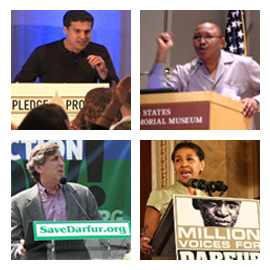About

Interviewing Vice President Riek Machar while covering the South Sudan referendum for The Washington Post
Rebecca Hamilton is a Professor of Law at American University, Washington College of Law (WCL), where her research and teaching focus on human rights and informational technology, national security law, international law, and criminal law.
Articles

The ‘Year of Climate’ in International Courts
A backgrounder on how climate cases came before four international courts, with a summary of issues each court has been asked to address, offers a one-stop resource to refer to as opinions are issued in the weeks and months ahead. Read … Read more >>

Where is the ICC Prosecutor?
The silence emanating from the Prosecutor of the International Criminal Court (ICC), Karim Khan, is growing louder by the hour. Three full days after Hamas perpetrated atrocities inside Israel and took civilian hostages into Gaza, Khan has … Read more >>

Facebook Beware
In its public-facing quarterly financial reports, Meta, the parent company of Facebook, Instagram, and WhatsApp, labels all countries in Africa, Latin America, and the Middle East as the “Rest of World.” Although one-third of Facebook’s … Read more >>
Scholarship

Platform-Enabled Crimes
B.C. L. Rev (2022). Online intermediaries are omnipresent. Each day, across the globe, the corporations that run these platforms execute policies and practices that serve their profit model, typically by sustaining user engagement. … Read more >>

Governing the Global Public Square
Harv. Int'l L. J. (2021). Social media platforms are the public square of our era – a reality that has been entrenched by the widespread closure of physical public spaces in response to the COVID-19 pandemic. And this online space is global … Read more >>

User-Generated Evidence
Rebecca Hamilton, User-Generated Evidence, Col. J. Transnat'l L. (2018) Around the world, people are using their smartphones to document atrocities. Smartphone apps designed to allow Users to record material that will meet evidentiary … Read more >>
Risks of Citizen Engagement
Excerpted from FIGHTING FOR DARFUR. Copyright © 2011.
All rights reserved.
^ Return to Top
Built on the Genesis Framework & WordPress
© 2024 Rebecca Hamilton




Questions for the advocacy community: Q2 – Jill Savitt
Q2: Is citizen advocacy at its most effective when it generates maximum “noise” on an issue , or do citizen advocates need to attach particular policy prescriptions to the noise they make?
Jill Savitt:
The answer is, of course, somewhere in between: In my experience, citizen advocacy is most effective when it generates maximum noise about an issue about which there exists a community-supported policy prescription. The citizen advocates do not have to attach, directly, a policy piece to their noise … but they should make sure: (1) there is a supportable, realistic policy prescription that can be advanced and is being advanced (2) that their noise is consistent (in message and tone and symbols, etc.) with the details of any policy prescriptions.
Noise and policy do not need to be connected, but advocacy is far more effective when these strategies are coordinated or complementary, even loosely.
Noise, by itself, can recruit constituents. Noise and theatrics can be good for media attention. But the cost of having noise without policy is that you make it easier for policymakers to avoid taking action. It is easier to hold them to a specific request (pass or sign X, support Y) than a general call to do something.
Noise alone gets harder and harder to organize. After the first few efforts, if there is no success and there is no “answer” to the problem, advocates will tire.
Finally, noise alone can make the noisemakers – and even the issue — appear to be fringe. Without a practical response, noise is just that – hard to listen to.
In the ideal world, the citizen advocacy and the policy prescription are of a piece – considered and executed to complement each other. In the even more ideal world, these components are considered in the context of all the strategic issues that affect change in the real world on the issue at hand.
Jill Savitt is the Executive Director of the Genocide Prevention Project